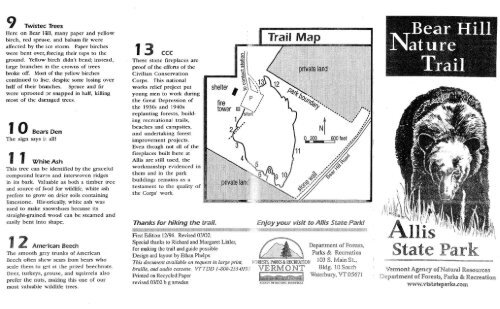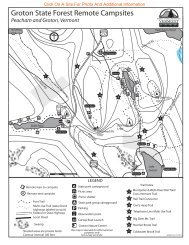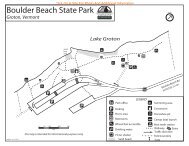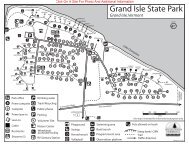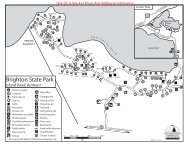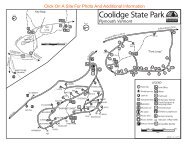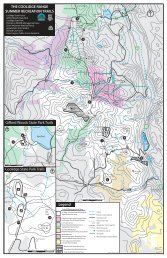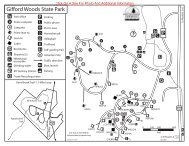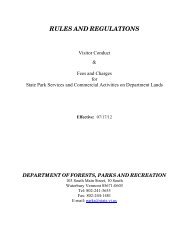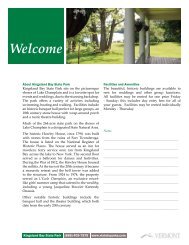Allis Nature Trail - Vermont State Parks
Allis Nature Trail - Vermont State Parks
Allis Nature Trail - Vermont State Parks
You also want an ePaper? Increase the reach of your titles
YUMPU automatically turns print PDFs into web optimized ePapers that Google loves.
9 Twisted Trees<br />
Here on Bear Hill, many paper and yellow<br />
birch, red spruce, and balsam fir were<br />
affected by the i.ce storm. Paper birches<br />
were bent over, forcing their tops to the<br />
ground. Yellow birch didn't bend; instead,<br />
large branches in the crowns of trees<br />
broke off. Mos1 of the yellow birches<br />
continued to live, despite some losing over<br />
half of their branches. Spruce and fir<br />
were uprooted Dr snapped in half, killing<br />
most of the damaged trees.<br />
10 Bears Den<br />
The sign says ii all!<br />
1 1 WhiteAsh<br />
This tree can be identified by the graceful<br />
compound leaves and interwoven ridges<br />
in its bark. Valuable as both a timber tree<br />
and source of food for- wildlife, white ash<br />
prefers to grow on drier soils containing<br />
limestone. Historicatry, white ash was<br />
used to make snowshoes because its<br />
straight-grained wood can be steamed and<br />
easily bent into shape.<br />
12 American Beech<br />
The smooth gray trunks of American<br />
Beech often show scars from bears who<br />
scale them to get at the prized beechnuts.<br />
Deer, turkeys, grouse, and squirrels also<br />
prefer the nuts, malting this one of our<br />
most valuable wildlife trees.<br />
13 ccc<br />
These stone fireplaces are<br />
proof of the efforts of the<br />
Civilian Conservation<br />
Corps. This national<br />
works relief project put<br />
young men to work during<br />
the Great Depression of<br />
the 19308 and 1940s<br />
replanting forests, building<br />
recreational trails,<br />
beaches and campsites,<br />
and undertaking forest<br />
improvement projects.<br />
Even though not all of the<br />
fireplaces built here at<br />
<strong>Allis</strong> are still used, the<br />
workmanship evidenced in<br />
them and in the park<br />
buildings remains as a<br />
testament to the quality of<br />
the Corps' work.<br />
Thanks for hiking the trail.<br />
shelter<br />
fire<br />
tower<br />
I<br />
,-,,,,,;,,,," <strong>Trail</strong> Map<br />
First Edition 12/94. Revised 03102.<br />
Special thanks to Richardand Margaret Littler,<br />
for making the trail and guide possible<br />
Design and layout by Ethan Phelps<br />
This document available on request in large print, FORESTS, PARKS & RECREATION<br />
braille, and audio cassette. VTTDD J-800-253-0J9} VERM 0 NT<br />
Pri~ted onRecycled Paper<br />
revised 03/02 b g amsden AGENCY or NATURAL RESOURCES<br />
Nt<br />
o 200<br />
- I<br />
Enjoy your visit to <strong>Allis</strong> <strong>State</strong> Park!<br />
I~I<br />
Department of Forests,<br />
<strong>Parks</strong> & Recreation<br />
103 S. Main si.,<br />
Bldg. 10 South<br />
Waterbury, VT 05671<br />
Par<br />
l::Y' .2'.liZiL==a b=. • ~;;;==X:==>2::;=:::::J<br />
Vl2lrffiont Agency of Natural Resources<br />
lDlepartment of Forests, <strong>Parks</strong> & Recreation<br />
www.vtstateparks.com
WIITelcome<br />
"r<br />
to the Bear Hill <strong>Nature</strong> <strong>Trail</strong>. The stops in this guide<br />
correspond to numbered sign posts along the trail. The 0.15 mile trail<br />
is marked with blue blazes and is moderate in di{ficuidy. Average hiking<br />
time is about an hour.<br />
1 Forest Succession<br />
Compare this area with the meadow<br />
around the fire tower. If mowing or livestock<br />
grazing cease, a variety of plants<br />
begin to challenge the grasses. Here is an<br />
"old field" condition where woody plants<br />
such as chokecherry, spirea, blackberry,<br />
and red-osier dogwood have become<br />
established. Young trees like maple and<br />
birch are finding room to grow. This<br />
property belonged to Mr. Wallace <strong>Allis</strong>,<br />
who farmed the area until giving it to the<br />
<strong>State</strong> in 1931.<br />
Red §prlUce' Stand<br />
Note the different understory here. The<br />
lack of available sunlight and acid from<br />
decaying spruce needles make it difficult<br />
for small plants to grow beneath the<br />
spruce. Spruce have shall ow roots and<br />
are easily toppled by the wind, which is<br />
why fallen. trees are common ill11 spruce<br />
stands.<br />
5 Habitat Transition<br />
, This area is mixed with hardwood and<br />
softwood forest. The light green fern is<br />
hay-scented fern and the large three-part<br />
fern is bracken fern. Both ferns are<br />
associated with poorer, drier forest sites<br />
and plenty of sunlight. They can delay<br />
the establishment oftree seedlings by<br />
shading, by the spreading of their<br />
rootstocks, and by chemicals released<br />
from their leaves that inhibit the growth<br />
of other plants. Notice the potential<br />
animal "homes" in standing dead trees in<br />
this area.<br />
~7"<br />
fungi<br />
These primitive plants are an integral<br />
part of the cycle of Iife in the forest. They<br />
aid in recycling plant and animal matter<br />
by breaking them down into simpler<br />
forms. Some weaken Dr kill trees, while<br />
others live on dead or downed wood or<br />
fallen leaves.<br />
2:<br />
. ..<br />
<strong>Vermont</strong>s Agricultural<br />
History<br />
can be read in the stone walls that snake<br />
through the forests. Other clues that this<br />
was once farmland include domestic<br />
plants like this apple tree growing in the<br />
woods.<br />
4(]yb MIO~$e§<br />
These ancient plants are not actually<br />
mosses. They are allied with ferns and<br />
usually are evergreen. Most grow in<br />
colonies that are interconnected. When<br />
flash photography was in its infancy, the<br />
spores of clubmosses were collected.<br />
When ignited, the spores produce a quick,<br />
bright flash suitable for picture-taking.<br />
6 Butternut<br />
This lovely tree is famous for its tasty<br />
walnut-like nuts and rich-colored wood.<br />
Concentrations of these trees in New<br />
England are often associated with Native<br />
American campsites. Butternut as a<br />
species is in decline over much of its range<br />
due to a mysterious fungal disease known<br />
as "butternut canker." Research is now<br />
focusing on certain trees that may show<br />
resistance to this fungus that is spread by<br />
rain splash and animals. You may notice<br />
the lovely maidenhair ferns growing at<br />
the base of this tree. They prefer rich<br />
soils high in calcium and often indicate<br />
limestone derived soils.<br />
8<br />
Great<br />
from Great Storms;<br />
It was not possible to see North and South<br />
Ponds from this point before January 9,<br />
1998. The "Great Ice Storm of '98"<br />
knocked down or bent over many trees on<br />
the eastern slope of Bear Hill, and many<br />
other mountains throughout the northeast.<br />
This large-scale forest changing<br />
event has advanced the successional<br />
process here by knocking down many of<br />
the more intolerant. pioneer species, like<br />
paper birch. It won't "be long, though,<br />
before this view is lost to the woods again.<br />
Views


